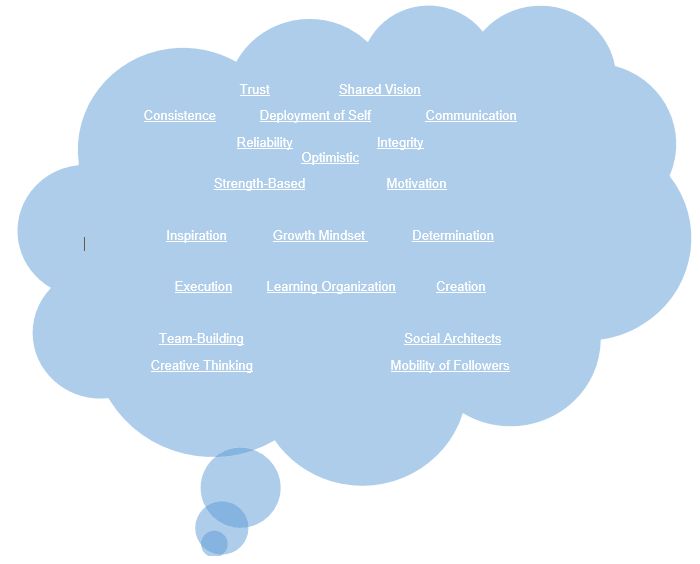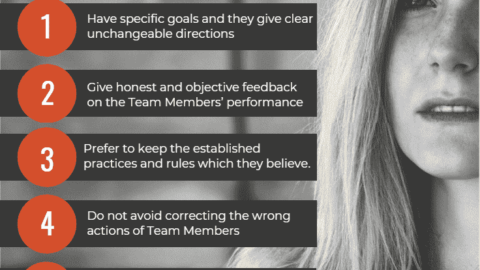What is Transformational Leadership Style?
Today, we are going to talk about Transformational Leadership. What is Transformational Leadership? How could we illustrate an accurate Transformational Leadership Definition? If we could exemplify Transformational Leadership, what would be some of the Transformational Leadership Examples? What could you achieve by using Transformational Leadership Style?
Table of Contents
In our each article, we thoroughly research a subject that we happen to know will help you achieve success in both your Business Environment and Self-Growth. In each article, we present tips, techniques, methods with proven efficiency, how did the theorist themselves came up with that technique, and so much more!
Before moving on, make sure to bookmark Project Cubicle to not miss any article, and we’ll make sure to bring better tips and techniques with Proven Success and Efficiency in each article!
If Your Actions Inspire others to Dream More, Learn More, Do More, and Become More, You are a Leader.
John Quincy Adams
Leaders. They inspire people around them; they inspire them to hustle, they inspire them to be better. Leaders. They inspire confidence. They inspire self-growth. They inspire Acceptance of Failure. They inspire Curiosity. They inspire Determination. They inspire Persistence. They inspire Patience. They inspire Strength. They inspire, by walking the talk themselves, you to Become a Better, Greater, Stronger, Smarter, Determined Version of You.
Leaders motivate people around them towards relentless improvement with their growth-mindset and openness to relentless learning. A Good Leader knows, while opening their eyes when the sunlight reaches that door, that It’s Time.
It’s Time to Get Up and Do Better than Yesterday, Be Better than Yesterday, More Knowledgeable than Yesterday.
How?
By Being Present in Every Single Moment.
Before we begin, I’d like to be open about the fact that this theory received many criticisms. These criticisms were about not having a solid focus point, treating leadership like it is not a reciprocal relationship between the Leader and the Team Members, having excessive subtitles and characteristics for the leader, and such.
The first reason I wanted to mention this here is because of the factor of Individual Differences. Each individual will choose to apply this technique in their own way, and therefore their applications of the model will differ. Everyone brings another component, resulting from their own unique characteristics and the perspective they perceive Leadership from.
The answer to “What is Leadership?” will differ, and it’s beautiful because it gifts us a Diverse Leader and Unique Team Members.
The second reason is that I believe taking something new from each article, re-inventing the technique or theory in our own way, applicable to our own characteristics and perspective, and implementing a mixture to our Workplace.
At Project Cubicle, in each article, we do our best to arm you with the right tools and ingredients; for you to have The Best mixture.
Without further ado, Transformational Leadership Style.
“Transformational Leaders don’t start by denying the world around them. Instead, they describe a Future they’d like to Create instead.”
Seth Godin
What is Transformational Leadership: Transformational Leadership Definition
To introduce Transformational Leadership, I’d like to introduce a Thought Bubble.
The Thought Bubble consists of phrases and adjectives that define Transformational Leadership, according to the Leadership Experts. These thoughts should give you an idea about Transformational Leadership Definition.
Since we are going to cover each of these characteristics and skills in the coming paragraphs, we just wanted to leave them here to trigger some Brainstorming.
Decoding Transformational Leadership Style
Knowledge + Experience + Coaching = Transformation
Transformational Leaders, Create a Shared Vision, Inspire and Motivate their Team to Execute that Mission by Building Trust, and as a result, Transform their Work Environment.
Leadership experts gather these skills under 4 Main Titles, or 4 Types of Behaviors:
- Idealized Influence
- Inspirational Motivation
- Intellectual Stimulation
- Individualized Consideration
We are now going to explore these 4 Types of Behaviors and provide a simple formula for each of them below.
Without further ado, let’s do it!
1. Idealized Influence
{Work Hard + Be a Role Model + Be Ethical + Inspire + Emphasize a Common Mission}
The first Transformational Leadership Style is about Attitudes, being the Ideal Role Model for the Team Members. It’s all about “Walking the Talk”, inspiring people by Practicing what They Preach, Winning Their Trust with Your Own Actions, and with High Standards and Ethical Principles, Keeping Their Needs Above Your Own.
The importance of Psychology is massive when it comes to leadership. If you have an Idealized Influence, as a Leader, in your Team Members’ eyes, they will begin to have you as their Role Model. This process is usually unconscious, meaning that the Team Members do not choose to have you as their role model on their own, but you win their trust via your actions and gentle approach towards them.
Once again, Idealized Influence:
- Ideal Role Model
- “Walk the Talk”
- “Practice what they Preach”
- Win Trust Through Actions
- Follower’s Needs Above Their Own
- High Standards and Ethical Principles
2. Inspirational Motivation
{Developing a Promising Vision + Captivating & Inspiring Stories + Emotional Appeals to Work Harder}
Remember, we’ve been discussing Inspiration in almost each of our articles? Leadership is about providing Inspirational Motivation to your Team Members so that they can achieve a Better Version of Themselves. You inspire them to be confident and motivated with your Consistent Vision, Set of Values, Enthusiasm and Optimism, Emotional Appeals and High Expectations. You motivate them to get out of their comfort zones to achieve the task they are given or achieve self-growth through the inspiration you brought them.
Read it again. Consistence. Consistence is Vital. Transformational Leadership is not about daily actions, it’s about repeating them hundreds of times and turning these behaviors into a habit. There is no such thing as becoming a Transformational Leader overnight, you have to be persistent and wake up, with determination, with each day’s sunlight to become one, to achieve Full Potential.
To repeat, Inspirational Motivation:
- Inspiration of Confidence and Motivation
- Consistent Vision
- Mission and Set of Values
- Sense of Meaning
- Enthusiasm and Optimism
- Excellent Communication
- High Expectations
- Emotional Appeals
3. Intellectual Stimulation
{Coaching & Mentoring + Encouraging Creativity and “Outside the Box Atmosphere” + Tolerance for Mistakes/Failures + Calculated Risks}
A Leader Stimulates. A Transformational Leader Stimulates Team Members to have better ideas, more efficient, more creative, with more vision; for More. With this attitude of the Transformational Leader, Team Members feel encouraged to share new ideas, they know they will not be judged if they fail and instead learn from their mistakes and polish themselves for the next task. They will engage to find creative and daring solutions to solve problems in the work environment, and they will find themselves in a pull for complexity and challenges.
The Transformational Leader, via Intellectual Stimulation, provides objective and constructive feedback but avoids harsh criticism of mistakes in the workplace. The Transformational Leader encourages the Team Members to learn through Change.
In short, Intellectual Stimulation brings:
- New ideas
- Avoidance of Criticism for Mistakes
- Change and Experience
- Encouraged Autonomy
- Big Picture and Challenged Assumptions
- Engagement in Problem Solving
4. Individualized Consideration
{Coaching + Listening + Offering Resources}
Being a Leader does not mean being self-centered and having “alpha” skills to top the competitors in the work field. Being a Transformational Leadership does not refer to being a dictator, and you should not.
You should be genuine about your concern for needs and feelings of your Team Members. I’d like to note here that various sources refer to Team Members as “Followers”, I think this implies following without questioning, which is the reason I am doing my best do avoid using this term. Following implicates inaction, and I find that strictly inaccurate.
For a Transformation to happen in the workplace, each Team Member should criticize and interrogate the Transformational Leader’s vision and thoughts, to reach a better end, to have a better outcome, to achieve real and continuous success and an alliance between the Leader and Team Members. Individualized Consideration does not indicate discrimination.
Shortly, Individualized Consideration requires:
- Genuine Concern for needs and feelings of Team Members
- Personalized Attention, Constructive and Objective Feedback
- Coaching and Mentorship
- Empowerment and Support
- Leading Towards the Right Direction
Time to Review What We Discussed on Transformational Leadership Style
In this article, we’ve explored the Art of Transformational Leadership Style. We learned that a Transformational Leader Generates a Shared Vision, Builds Trust-Based Relationship with Their Team and Motivates Them to Bring the Shared Vision Into Life. The attitude of Transformational Leader leads to emergence of Confident, Enthusiastic, and Loyal Team Members in the work area and as a result, Improved Performance and Continuous Success! We furthermore discovered that these skills were organized as the 4 main components of Transformational Leadership Style. These Behavior Types were Idealized Influence, Inspirational Motivation, Intellectual Stimulation, and Individualized Consideration. We also strictly pointed out that Transformational Leadership should not imply Dictatorship in the workplace.
And we conclude what we have to say about Transformational Leadership here.
Which component do you think is the Most Important to Achieve Transformation in the Work Environment?
If you could make an addition to this organization of Transformational Leadership, what would it be?
Is there a subject you’d like us to cover in one of our articles?
Let us know in the comments!
Also Read
Role of Emotional Intelligence and Leadership Styles
Transactional Leadership Style
Further Reading











